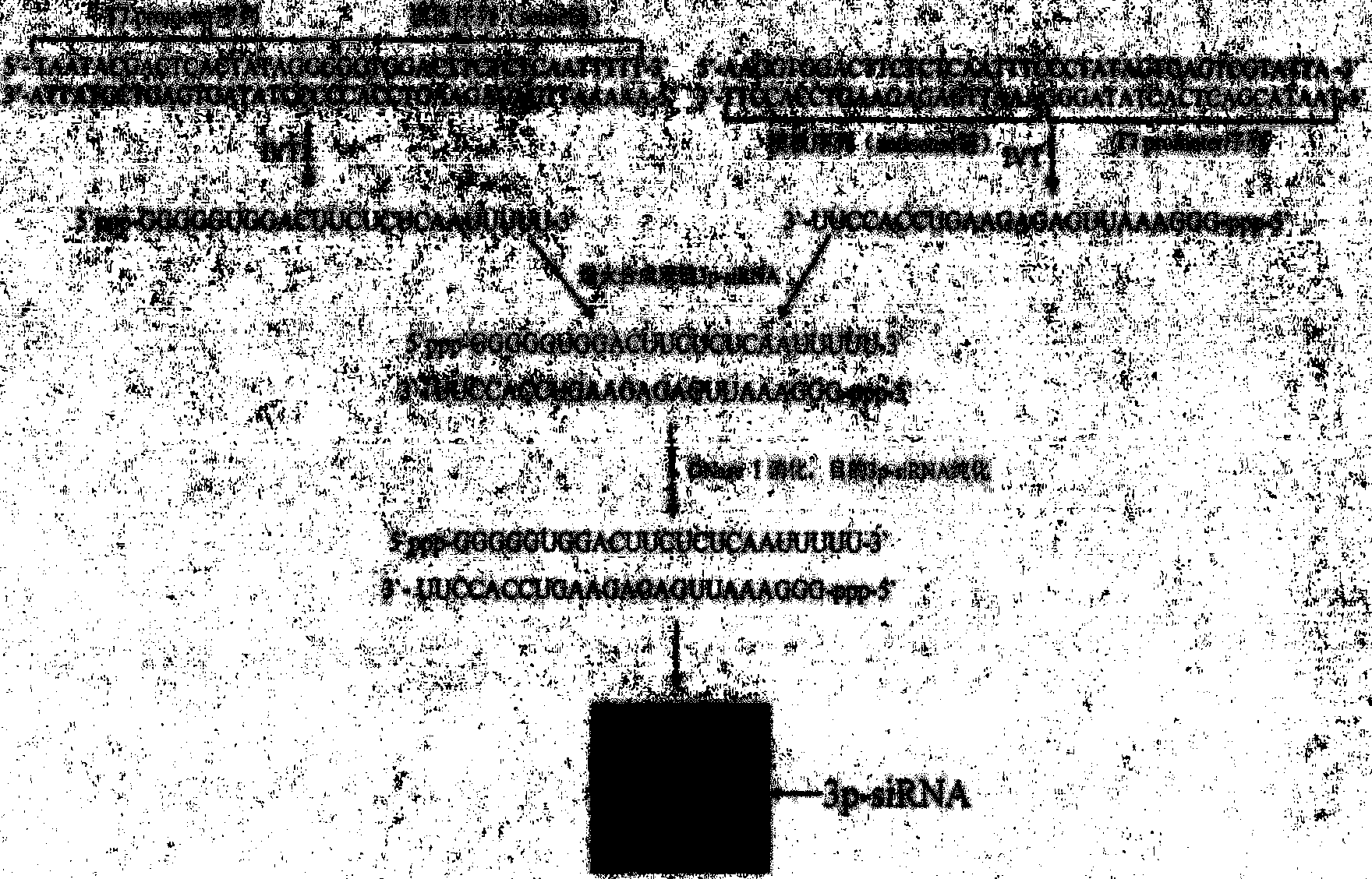Difunctional 3p-siRNA inhibiting hepatitis B viruses, and application thereof
A dual-function, anti-viral technology, used in DNA/RNA fragments, anti-viral agents, recombinant DNA technology, etc., to achieve the effect of inhibiting HBV replication
- Summary
- Abstract
- Description
- Claims
- Application Information
AI Technical Summary
Problems solved by technology
Method used
Image
Examples
Embodiment 1
[0021] Example 1: Cell-level toxicity evaluation of 3p-siRNA(s / p)
[0022] 1.HepG2.2.15 cell culture
[0023] HepG2.2.15 cells were cultured in DMEM medium containing 10% fetal bovine serum and 200ug / ml at 37°C and 5% CO2 incubator. Observe that the cells grow well. After culturing to the logarithmic growth phase, inoculate HepG2.2.15 cells in a 96-well plate (1×10 4 Cell / well), continue to culture.
[0024] 2.3p-siRNA transfection
[0025] The cells inoculated into the 96-well plate were cultured for 24 hours. After the cells grew to 40-60% confluence, without G418, use the transfection reagent jetPRIME and follow the instructions to transfect 3p-siRNA (100nM) for 6 hours Then change to normal cell culture medium (DMEM cell culture medium containing 10% FBS), 37℃, 5% CO 2 Continue to cultivate.
[0026] 3.MTT detection
[0027] 3p-siRNA was transfected according to the above method, the concentration was 100nM and 500nM respectively, and the cell control was set up. Five multiple well...
Embodiment 2
[0030] Example 2: 3p-siRNA(s / p) activates RIG-I-mediated interferon pathway
[0031] 1.293T cell and HepG2.2.15 cell culture
[0032] The cells were cultured in DMEM medium containing 10% fetal bovine serum and 200ug / ml at 37°C and 5% CO2 in an incubator. Observe that the cell growth is in good condition. After culturing to the logarithmic growth phase, inoculate the cells in a 24-well plate containing G418-free, 10% FBS, and DMEM medium (3×10 6 Cells / well), continue to culture overnight.
[0033] 2.3p-siRNA transfection
[0034] The cells inoculated into the 24-well plate were cultured for 24 hours. After the cells were 40-60% confluent, the transfection reagent jetPRIME was used to transfect 3p-siRNA (100nM) according to the instructions in a serum-free state for 6 hours Then change to normal cell culture medium (DMEM cell culture medium containing 10% FBS), 37℃, 5% CO 2 Continue to cultivate.
[0035] 3. Dual luciferase reporter gene analysis method to detect interferon pathway act...
Embodiment 3
[0039] Example 3: Inhibition rate of 3p-siRNA(s / p) on HBsAg and HBeAg for 48 hours, 96 hours and 144 hours
[0040] 1.HepG2.2.15 cell culture
[0041] HepG2.2.15 cells were cultured in DMEM medium containing 10% fetal bovine serum and 200ug / ml at 37°C and 5% CO2 incubator. Observe that the cells grow well. After culturing to the logarithmic growth phase, inoculate HepG2.2.15 cells in a 96-well plate (1×10 4 Cell / well), continue to culture.
[0042] 2.3p-siRNA transfection
[0043] The cells inoculated into the 96-well plate were cultured for 24 hours. After the cells were 40-60% confluent, the transfection reagent jetPRIME was used to transfect 3p-siRNA (100nM) according to the instructions in a serum-free state for 6 hours Then change to normal cell culture medium (DMEM cell culture medium containing 10% FBS), 37℃, 5% CO 2 Continue to cultivate.
[0044] 3. ELISA method to detect HBsAg and HBeAg in cell culture fluid
[0045] The cell culture supernatant was collected 48, 96, and 144 ...
PUM
 Login to View More
Login to View More Abstract
Description
Claims
Application Information
 Login to View More
Login to View More - R&D
- Intellectual Property
- Life Sciences
- Materials
- Tech Scout
- Unparalleled Data Quality
- Higher Quality Content
- 60% Fewer Hallucinations
Browse by: Latest US Patents, China's latest patents, Technical Efficacy Thesaurus, Application Domain, Technology Topic, Popular Technical Reports.
© 2025 PatSnap. All rights reserved.Legal|Privacy policy|Modern Slavery Act Transparency Statement|Sitemap|About US| Contact US: help@patsnap.com



